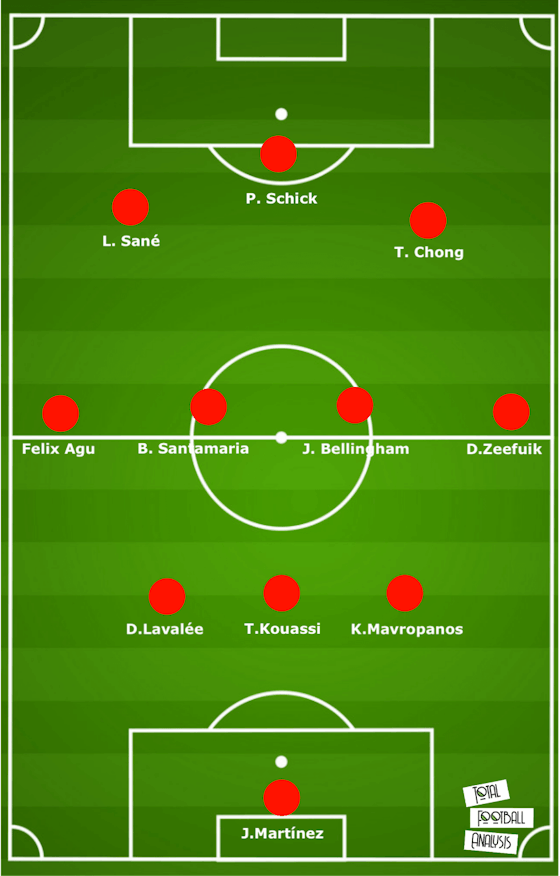Total Football Analysis
·24 September 2020
Building a team with the best new signings in the Bundesliga – data analysis
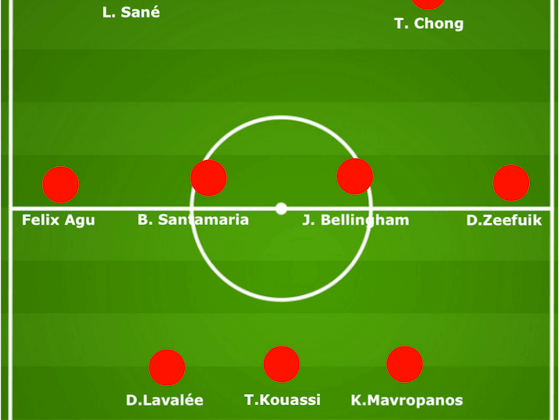
In partnership with
Yahoo sportsTotal Football Analysis
·24 September 2020

With the new Bundesliga season already underway, many new signings have already been made by the clubs in order to strengthen their squads wherever they need. The beginning of the season is always an exciting time for every club fan because they get to see the new players in their team make their first appearances and prove their value, but also for every football fan, as the transfer window is for a lot of us one of the most exciting times of the season.
In this data analysis, we will be taking a look at statistics from the new faces in the Bundesliga so we can see and understand their output in key metrics. We will use that data, analyse it, and compare the players’ statistical profile in order to identify the best in each position. After that we will build a team with the best players as well as leave some honourable mentions of names you should keep an eye on during the season as well.
For this data analysis, we are using data from Wyscout from last season, it is important to note that the players come from various teams and, as such, we should look at the stats having the difference of level and style of play between all the leagues in mind. Also worth noticing is that some players have little data available due to small playing time or the league from which they came and, in the appropriate section, they will be mentioned but not a part of the analysis as their data is not very accurate.
In order to find out the players that were newly signed in the Bundesliga we used data from Transfermarkt, we excluded players that moved from the club within the Bundesliga as the purpose is to discover what the “new faces” can bring to the league.
In order to build a team with the best players that will come out of this data analysis, we must first decide on a formation to use. Going for a personal favourite, we will be using a 3-4-3 formation to set up our players on the pitch, this means that our choices will also be influenced by the type of player needed in each position in this formation.
Having this in mind, we will be looking for the best three centre-backs or defenders that can play in a 3 at the back system, two wing-backs able to provide both defensive and offensive support, two central midfielders that are also capable both attacking and defending, although we can have one with a more defensive profile an the other with a more attacking one. In the attack, we will need two wingers/inside forwards able to operate in the half-spaces but also to play in wide areas if needed, and finally, one striker to occupy the front spot.
After all the filtering and adjustments, we were left with a pool of 36 players that will be a part of this analysis. Starting from the back, the first position we are going to analyse is the goalkeeper.
Goalkeepers
Shortlist:
Josep Martínez – 22 years-old ( from Las Palmas to RB Leipzig)
Lennart Grill – 21 years-old (from FC Kaiserslautern to Bayer Leverkusen)
Goalkeeper is the position where there are fewer options in terms of players with only two names to pick from, as such, only one graphic was enough to put these two goalkeepers head to head in key metrics as we can see below.
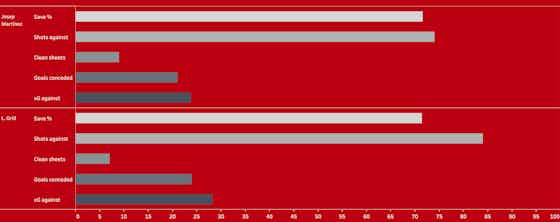
Based on the graphic we can see that both keepers have a similar profile in the analysed metrics, however, there is a big difference between their background and the level they played at. Josep Martínez was at Las Palmas playing in LaLiga 2 and Lennart Grill was at FC Kaiserslautern playing the German third division. This already indicates that Martínez is used to play at a higher level, he also displays a better number in most metrics, his save percentage of 71.62% is slightly higher than Grill’s 71.43% although he faced less shots (74) than the German (84). Martinez has also kept more clean sheets (9) than Grill (7) and both keepers managed to keep their goals conceded number below the xG against number.
Final choice
Josep Martínez: The Spaniard seems to have made a good move joining a great club for youngsters which is RB Leipzig and, judging by his stats, he looks like a good goalkeeper for his age. He will have serious competition for the goalkeeper spot in Péter Gulácsi.
Centre Backs
Shortlist:
Mike van Der Horn – 27 years-old (from Swansea City to Arminia Bielefeld)
Tanguy Nianzou Kouassi – 18 years-old (from PSG to Bayern Munich)
Dimitri Lavalée – 23 years-old (from Standard Liège to Mainz)
Nathan de Medina – 22 years-old ( from Mouscron to Arminia Bielefeld
Konstantinos Mavropanos (from Arsenal to Stuttgart)
Maxence Lacroix – 20 years-old (from Sochaux to Wolfsburg)
We are going to start by taking a look at the defensive statistics of the centre-backs in the shortlist, those are the most important metrics for this position and, in order to compare players, we plotted aerial duels won (%) and defensive duels won (%) on both axes. The colour of the squares represents PAdj (possession adjusted) interceptions per 90, a metric created to attenuate the difference in defensive metrics between players that play in teams with more and less possession of the ball during the games.
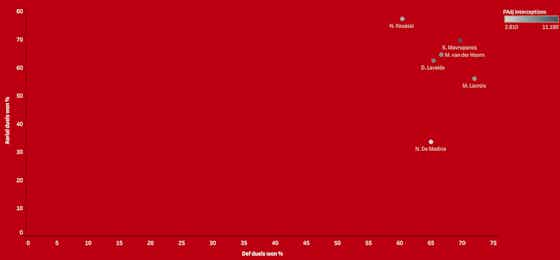
Looking at the scatter plot we see how Konstantinos Mavropanos stands out in all three metrics, the greek defender has a 69.66% win rate on his defensive duels and a 69.44% win rate on his aerial duels ranking 2nd in both metrics while also boasting 11.18 Padj interceptions per 90 which is the highest number amongst the centre-backs. Mike van Der Horn and Dimitri Lavalée come in with similar profiles but with the first having a slight edge over the latter. Tanguy Kouassi deserves a mention as well, the teenager has the best win rate when it comes to aerial duels (77.08%) but falls a bit shorter on the percentage of defensive rules he wins (60.38%) and only averages 5.27 PAdj interceptions per 90.
In modern days football centre-backs need to be just as good on the ball as they are defending, players in this position are often the ones starting the team’s build-up process and therefore need to have good passing abilities to circulate and progress the ball. In this next scatter plot we’ll take a look at basic passing metrics: passes per 90 and pass accuracy.
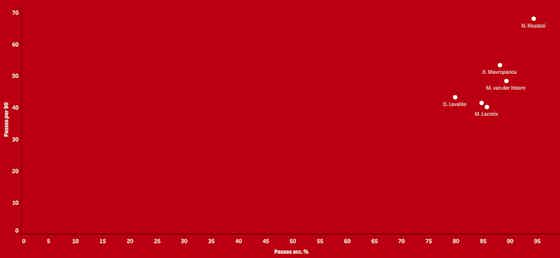
Our “honourable mention” from the defensive section is now the standout player in this passing plot. Tanguy Kouassi clearly stands out from the rest of the players, the Frenchman averages 67.85 passes per 90 with an impressive 94.33% completion rate ranking first in both metrics. The same names appear again, only this time behind Kouassi, Mavropanos and van Der Horn are the next best two in this passing scatter plot. The greek 53.26 passes per 90 with a completion rate of 88.14% and the Dutch averages 48.32 passes per 90 with an 89.28% completion rate.
Now that we know the pass volume and accuracy of the players, we are going to analyse how much they are able to create with those passes. Being part of the first build-up phase, centre-backs are the players tasked with progressing the ball up the pitch a lot of times by playing line breaking passes into the opposition’s side of the pitch. In this next scatter plot we are going to analyse the metrics progressive passes per 90 and dangerous passes per 90. Dangerous passes per 90 is a metric created by adding deep completions per 90, passes into the final third per 90 and passes into the penalty area per 90. This metrics will allow us to evaluate the player’s ability to progress the ball up the pitch and also to get the ball into dangerous areas.

An analysis of the scatter plot shows us Kouassi standing out once again but this time with Lavalée displaying a similar profile. Kouassi ranks first in terms of progressive passes per90 with 10.98 and second in terms of dangerous passes per 90 with 10.04, Lavalée on the other hand, ranks second in terms of progressive passes per 90 with 10.37 and first in terms of dangerous passes per 90 with 10.46. Mavropanos also shows a good number with 10.28 progressive passes per 90 but falls a bit short in terms of dangerous passes per 90 when compared to the others with 6.12.
Final choices:
Konstantinos Mavropanos – The 22 year-old greek centre-back shows great stats defensively while also maintaining good numbers on his passing and ball progression. On loan from Arsenal, Mavropanos looks like an exciting prospect in the “modern” centre-back role and the Gunners will surely be monitoring their player to see his development.
Tanguy Nianzou Kouassi – The PSG academy graduate came to Bayern Munich for free and what a deal this looks for the German champions. Kouassi displays solid defensive numbers with an impressive win rate on his serial duels but where he really shined in the analysis was in his passing, progressive passing and creativity. The youngster looks like a defender very capable of playing the “build-up starter” role, picking out line-breaking passes while also providing good defensive cover. Of course, there is improvement to be made but Kouassi is definitely one to watch.
Dimitri Lavalée – To finish off the centre-back trio is the 23-year old Belgium that was signed by Mainz from Standard Liège. Lavalèe is a versatile player that can also play as a left-back if necessary. He is good on the ball and was a standout in the ball progression and creativity through passing during our analysis. Lavalée also displayed good defensive number and all in all he looks like another good young prospect coming into the Bundesliga.
Wing-Backs
Shortlist:
Left wing-backs
Felix Agu – 20 years-old (from Vfl Osnabrück to Werder Bremen)
Jacob Laursen – 25 years-old (from Odense BK to Arminia Bielefeld)
Nathan de Medina – 22 years-old (from Mouscron to Arminia Bielefeld)
Right wing-backs
Thomas Meunier – 29 years-old (from PSG to Borussia Dortmund)
Benjamin Henrichs – 23 years-old (from AS Monaco to RB Leipzig)
Valentino Lazaro – 24 years-old (from Inter Milan to Borussia Monchengladbach)
Deyovaisio Zeefuik – 22 years-old ( from FC Groningen to Hertha Berlin
Robert Gumny – 22 years-old ( from Lech Poznan to Augsburg)
Wing-back is a vital position in our chosen formation as they need to be able to defend but also be up the pitch to attack and provide width to the team. Again, we are going to start with the defensive metrics and by analysing the scatter plot below that shows aerial duels won (%) and defensive duels won (%) on both axes. The colour of the circles represents the amount of PAdj (possession adjusted) interceptions per 90.

Starting with the left-backs, Felix Agu clearly stands out from the rest defensively, the German wins 61.80% of his defensive duels and 50.77% of his aerial duels while also averaging 4.15 PAdj interceptions per 90. Jacob Laursen is the player with the best number of PAdj interceptions per 90 with 6.17 but is defensive output in the other metrics is quite low while Nathan de Medina has a good win rate in his defensive duels (65%) but falls short in the other metrics winning only 33% of his aerial duels and averaging 2.81 PAdj interceptions per 90.
Moving on to the right-backs the number of players to choose from becomes bigger. Apart from the rest on the right upper corner is Deyovaisio Zeefuik, the Dutch has an impressive win rate of 73.33% on his defensive duels which is the best amongst our players, and also has the second best win rate when it comes to aerial duels with 52.83%, two very good stats that he tops off with an average of 6.53 PAdj interceptions per 90. Also standing out from the rest is Thomas Meunier, the Belgian has the 2nd best win rate in terms of defensive duels (60.16%) and the best in terms of aerial duels (56.10%), numbers he combines with an average of 6.43 PAdj interceptions per 90. Last but not least, Robert Gumny also displays good numbers in the analysed metrics. The Polish wins 59.88% of his defensive duels and 48.19% of his aerial duels but where he really shines is in his average of 8.68 Padj interceptions per 90 which is the highest in the group.
Now we are going to take a look at the player’s offensive contribution, for that, we took a look at key metrics to determine their output and creativity. We created the metric “Dangerous crosses per 90” by adding crosses to the goalie box per 90 and deep completed crosses per 90, we also created the metric “Chance creation contribution per 90” by adding second assists per90, third assists per 90, assists per 90 and key passes per 90.

Starting with the left-backs, Laursen is one that presents the highest offensive contribution of the three, he attempts the most crosses per 90 (2.63), has the highest number of dangerous crosses (1.49) and dangerous passes (7.64) and contributes to the creation of the most chances per 90 (0.35). Nathan de Medina only really shines in terms of progressive actions per 90 (9.94) with dangerous passes per 90 being the only other metric he doesn’t rank last. Finally, Felix Agu displays a balanced profile with good numbers in all metrics, he averages 6.97 progressive actions per 90, 1.98 crosses per 90 with 0.8 of this being dangerous crosses, 5.3 dangerous passes per 90 and contributes to the creation of 0.25 chances per90.
Looking at the right backs, the same three names from the defensive sections stand out, with Benjamin Henrichs appearing very well in some metrics too. The German ranks the highest in terms of progressive actions per 90 (12.88) and third in terms of dangerous passes per 90 (8.78). Consistently ranking first in the metrics is Thomas Meunier, the Belgian is the best in terms of crosses per 90 (3.93), dangerous crosses per 90 (2.05) and chance creation contribution (0.83). Coming close to Meunier is Zeefuik, the Dutch is the best in terms of dangerous passes per 90 (10.99) and ranks second in almost every other metric. Robert Gumny takes the “bronze medal” in this analysis and ranks third in almost every metric.
Final Choices
Felix Agu – The 20-year-old German left-back looks like an interesting player with some potential to grow. Defensively he displays very good stats which is important but his offensive contribution is not bad at all, making him a well balanced full-back that has the room and potential to grow in his new team.
Deyovaisio Zeefuik – Zeefuik ends up being the choice over Thomas Meunier because of his youth but also because he shows really impressive stats. Very strong both defensively and in the attack, he looks like a very good addition to Hertha Berlin’s team and surely one to watch this season in the Bundesliga.
Central midfielders
Shortlist:
Reinier – 18 years-old (from Real Madrid to Borussia Dortmund)
Jude Bellingham – 17 years-old (from Birmingham to Borussia Dortmund)
Guus Til – 22 years-old ( from Spartak Moscow to Freiburg)
Baptiste Santamaria – 25 years-old ( from Angers to Freiburg)
Sebastian Griesbeck – 29 years-old (from FC Heidenheim to Union Berlin)
Patrick Erras – 25 years-old ( from Nuremberg to Werder Bremen)
Wataru Endo – 27 years-old (from St. Truiden to Stuttgart)
We will start our analysis of the centre midfielders by taking a look at the player’s successful actions both in attack and in defence, this way we can have a first glance at the profile of midfielders we have.

Analysing the graphic we can clearly see that there are different types of midfielders in our shortlist, some with a more defensive profile, some with a more attacking profile, and one that participates in both moments very well. Jude Bellingham joined Dortmund from Birmingham and all the hype around him seems to be very deserved, Bellingham is the only player to rank above average on both attacking (3.97) and defensive actions (10.31) and actually has the most successful attacking actions. Wataru Endo tops the list in terms of successful defensive actions and Santamaria alongside Griesbeck both display defensive profiles. On the other hand, Reinier and Guus Till are the attacking midfielders of the list and, as such, present a more offensive profile.
Next, we are going to take a look at the midfielders’ defensive stats, followed by the passing and creativity ones. We compiled several graphs to gives a good view of the player’s defensive output.
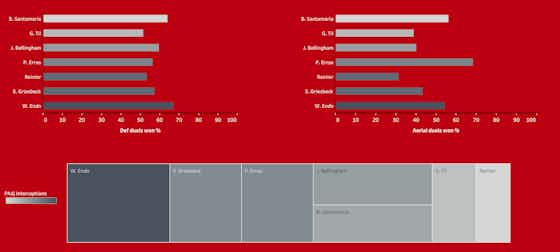
The three defensive midfielders of the list top the list on PAdj interceptions with no surprise, but in terms of defensive duels and aerial duels, all players display very similar numbers with Endo and Santamaria slightly surpassing the group on the first metric and Erras clearly topping the chart in the second metric.
The next graph shows us the pass volume and accuracy of the players and will allow us to see which players are more involved in the game through passing and which do it consistently well.
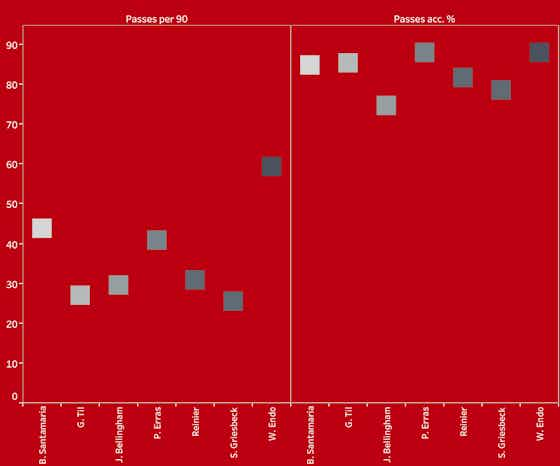
Wataru Endo is the player with the highest volume of passes per 90 (59.23) and the second best completion rate (87.90%). Two other defensive midfielders have a high volume of passes per 90, Santamaria and Erras both average more than 40 passes per 90 with a completion rate of over 84%. A bit further up the pitch, and possibly with more risky passes, Jude Bellingham, Reinier, and Guus Till all have similar passing volumes ranging from 26 to 30, with Bellingham’s completion rate falling below the other 2 at only 74.67%.
Having seen the pass volume and accuracy of the players is now time to analyse the impact and the danger they are able to create with the passes they make as well as their ability to progress the ball.
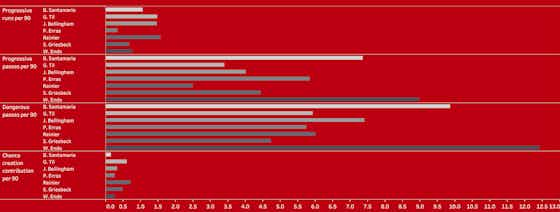
Starting with ball progression, Til, Reinier and Bellingham are the players with the most progressive runs per 90 with values around 1.5. In terms of progressive passes, Endo tops the chart with 8.97 followed by Santamaria with 7.36. Patrick Erras also has a high number of progressive passes per 90 (5.83) with Bellingham and Till falling just under him.
Looking at creativity, Endo is again the midfielder that stands out when we look at dangerous passes per 90 (12.41) and Santamaria gets the second place as well (9.86). Jude Bellingham comes just under the previous two with 7.40 dangerous passes per 90 with the other players showing similar profiles between them.
Lastly, in terms of chance creation, Reinier is the player that contributes to the creation of the most chances per 90 (0.71) followed by Till (0.61) and Griesbeck (0.49).
Final Choices
Jude Bellingham: Jude Bellingham is a terrific young player that surely has a bright future in front of him. His move to Borussia Dortmund at only 17 clearly shows the quality the Englishman already has at such a young age and he is definelty one of the most promising players to come in the Bundesliga this season.
Baptiste Santamaria: The French is the more defensively minded player in the chosen ones and gets the edge over Endo because the Japanese came from a league with a lower level when compared to the Ligue 1. Furthermore, Santamaria is only 25 and still has some room for growth while Endo is already 27 and is just now making the move to a top 5 league.
Wingers
Shortlist
Keita Endo – 22 years-old (from Yokohama F. Marinos to Union Berlin)
Leroy Sané – 24 years-old ( from Manchester City do Bayern Munich)
Ritsu Doan – 22 years-old (from PSV to Arminia Bielefeld)
Tahith Chong – 20 years-old (from Manchester United to Werder Bremen)
In the winger/inside forward spot we are going to look at the player’s ability to create and cover chances, as well as their ball progression capabilities. This first graphic shows us key metrics related to chance creation and ball progression. It is worth mentioning that Leroy Sané’s stats are not from last season since he was injured the entire time, as such, data from his previous season (2018/2019) was used.
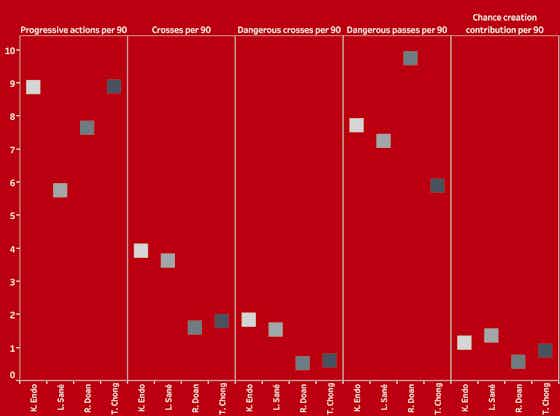
An analysis of the graphic shows us that Endo and Chong are the players with the most progressive actions per 90 with values around 9. In terms of crosses, Endo is also the player with the best numbers (3.93) followed by Leroy Sané (3.63). The same pair also has the best values in terms of dangerous crosses per 90 and rank 2nd and 3rd in terms of dangerous passes per 90 respectively. Ritsu Doan has the best value when it comes to dangerous passes per 90 but the Japanese falls short in other metrics. Looking at the player’s involvement in chance creation, Leroy Sané is the player involved in the creation of the most chances per 90 (1.36) with Endo coming second in this metric (1.14) and with Chong closing the top three (0.9).
The next step is to look at the direct goal contribution of the players, this will allow us to see how much of the passing and crossing translates into goals and assists. Goal contribution per 90 and xG goal contribution per 90 are two metrics we are going to use and they are obtained by adding goals per 90 and assists per 90 as well as xG per 90 and xA per 90.

Leroy Sané clearly stands out above everyone else in terms of goal contribution per 90 (0.91) and surpasses his xG contribution per 90 (0.6). Chong is the player with the best numbers besides Sané and has a goal contribution per 90 of 0.6 that surpasses his xG contribution of 0.28.
Final choices:
Leroy Sané – The choice of the German is a no brainer in this analysis, the main signing from Bayer Munich this season seems to be settling in very well and his quality is undeniable. Sané will arguably be one of the best wingers in the Bundesliga this season but faces very tough competition for his spot in the team.
Tahith Chong – The Manchester United loanee looks like a very exciting prospect and this season in the Bundesliga will certainly be a perfect opportunity for him to grow and show what he is all about. Definitely one to keep an eye for!
Strikers
Shortlist:
Hwang Hee-Chan 24 years-old (from RB Salzburg to RB Leipzig)
Patrick Schick – 24 years-old (from AS Roma to Bayer Leverkusen)
Ragnar Ache – 22 years-old from Sparta Rotterdam to Frankfurt)
Bartoz Bialek – 18 years-old (from Zaglebie Lubin to Wolfsburg
Ermedin Demirovic – 22 years-old (from Alavés to Freiburg)
Max Kruse – 32 years-old (free agent to Union Berlin)
Noel Niemann – 20 years-old (from 1860 Munich to Arminia Bielefeld)
Christian Bebauer – 26 years-old (from SCR Altach to Arminia Bielefeld)
The first scatter plot will look at has xG per 90 and non penalty goals per 90 on both axes, this metrics will allow us to see if strikers are getting into good scoring positions or not but also if they are scoring from the positions they get themselves in.
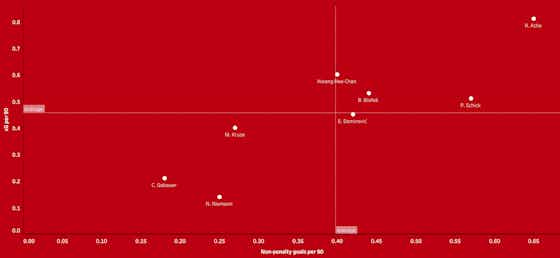
The best strikers here are the ones with a good balance between their xG and non-penalty goal value, if the xG value is high but they don’t score enough, they are not clinical, if the xG value is low then they aren’t getting into good scoring positions. Ragnar Ache stands out massively in this graphic but he is one of the mentioned cases, his xG per 90 value is the highest at 0.81 but he only has 0.65 non penalty goals per 90. With a better balanced profile, and with high numbers is Patrick Schick, he surpasses his 0.51 xG value with 0.57 non penalty goals per 90. With lower numbers but also a balanced profile is Demirovic who also surpasses his xG value in terms of goals.
We are now going to take a look at key metrics for the striker position, these metrics will allow us to analyse the shot volume and its relation to touches in the box per 90, the players’ goal conversion rate as well as their contribution to creating chances.
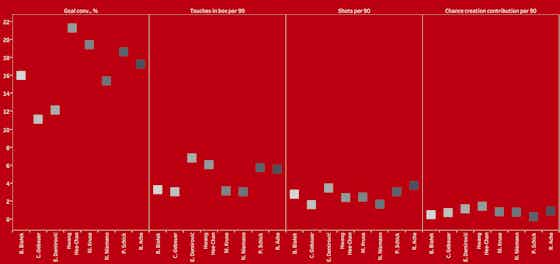
An analysis of the first metric shows us Hwang Hee-Chan with the best goal conversion rate (21.28%) followed by Max Kruse (19.44%) and Patrick Schick (18.64%). Ragnar Ache comes just below the mentioned with a conversion rate of 17.24%. In terms of touches in the box per 90 Demirovic is the player with the highest number (6.79) followed by Hwang Hee-Chan (6.04) and Patrick Schick (5.71) with Ragnar Ache coming fourth once again with 5.55 touches in the box per 90. When it comes to shots per 90 we have almost a mirror from the last one, however, Hwang Hee-Chan doesn’t stand out and Ragnar Ache averages 0.71 shots per 90 more than Patrick Schick. Finally, in terms of chance creation contribution, Hwang Hee-Chan is the player who contributes the most (1.41) followed by Demirovic (1.14) and Ragnar Ache (0.9) with Max Kruse falling just behind them (0.81).
Final Choice:
Patrick Schick: The choice ends up falling on the Patrick Schick mostly because of personal taste for the player. Schick performed very well in most metrics and, although Ragnar Ache and Hwang Hee-Chang displayed better numbers than him in some, he ends up getting the spot. Nevertheless, Hwang Hee-Chang and Ragnar Ache both look like two very promising strikers that will surely do well in the Bundesliga and that you should keep an eye on as well.
In this data analysis, we used statistics and data to measure the output of the “new faces” in the Bundesliga. Going through all positions, keeping in mind the chosen formation, we looked for the best in each one to make the final XI.
The Bundesliga is always an exciting season and this year will be no exception, this article ends with the final XI displayed on the chosen formation and gives not only 11 but 30+ players that you should see an eye on during this season.
